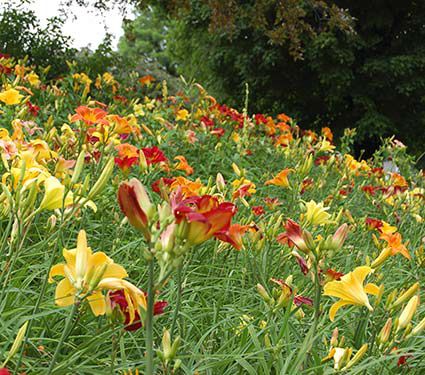






Daylily (Hemerocallis): Indestructible Beauty
We'd describe the Daylily as "the backbone of the perennial garden" except that would do a disservice to this most durable plant -- backbones, as every gardener knows, are fragile things, whereas Daylilies are close to indestructible. Thriving in a wide range of soils and in sun or partial shade, these long-lived perennials are sufficiently vigorous to function as a weed-suppressing ground cover. Pests and diseases rarely pose a serious threat if Daylilies are grown in suitable conditions and given minimal care.
A Daylily for Every Taste
Whether your taste in flowers tends toward the chaste or the shamelessly flamboyant, there is a Daylily for you. There were, in fact, at last counting some 60,000 distinct Daylily varieties; from this horde, we've selected a diverse but manageable assortment of the very best. If you want trumpets of snowy white with a cool, green throat, you can opt for 'Lady Elizabeth'. If you need a full-blooded, almost black, purple-red, we suggest 'Jungle Beauty'. You'll find every color here other than blue, and if you can't make decisions, you may purchase one of our collections or mixes, which offer a smorgasbord of different hues and flower types.
Weeks and Weeks of Flowers
As the name "Daylily" suggests, individual Daylily blossoms last only a day, but a given plant produces new flowering stems over some weeks, and if early bloomers are matched with midseason and late Daylilies, as in our "Unique 50 " mix, the result is a summer of unceasing bloom.
What We Ship
We ship large, field-grown plants that usually bloom the first year. They will outperform lesser grades offered elsewhere. Except as noted, all are "dormant" varieties, meaning their leaves are deciduous.
Daylily Growing Tips
Daylily - How to Care for Your Plant
Light/Watering: Daylilies will grow in full sun in the North and will tolerate the same in the South with sufficient moisture. Plants grow well in partial shade, which is preferred for varieties with pastel flowers. Daylilies are drought-tolerant once established, but perform best with consistent moisture.
Fertilizer/Soil and pH
These perennials prefer a well-drained loam with a pH approaching neutral. Soils rich in organic matter encourage profuse blooming, although many of the older hybrids will grow well even in a sandy situation. Fertilize lightly once the plants are established, but avoid using mixes high in nitrogen. A summer mulch is appreciated, since it will help soils retain moisture and buffer soil temperatures.
Pests/Diseases
Daylilies rank high on the list of plants resistant to insects and diseases. Thrips occasionally feed on buds or flowers, distorting the blooms and causing cork-like lesions on the flower spikes, which may then break at the affected area. Use insecticidal soap to discourage these tiny pests, and remove and destroy any infested buds or flowers. Spider mites can infest the foliage during hot, dry weather; wash them off with a forceful water spray regularly, or use an appropriate insecticide. Yellowing leaves and brown leaf tips result from normal senescence after flowering; regular grooming will keep plants looking fresh. If foliage becomes unsightly, cut it back to the ground, water well, and in time new foliage will appear.
Companions
Platycodon, Rudbeckia, Liatris, Shasta Daisy, and Echinacea are all fine companions for sunny situations; Ferns, Hosta, and Solomon’s Seal are lovely with Daylilies growing in shadier spots. If you underplant Daylilies with Daffodils, the foliage of the former will hide the foliage of the latter as it dies back, and you’ll get two gorgeous seasons of bloom from one area with very little maintenance.
Reflowering
Many reblooming varieties are now available; these require regular removal of old flowers to perform at their best. On all types of Daylilies, spent flowers should be snapped off daily and the entire flower scape should be cut off after all buds have passed.
Dividing/Transplanting
Daylilies should be divided every 3 to 5 years, and repeat-bloomers every two years since new growth supports the rebloom. Two spading forks held back-to-back and prised apart makes this chore easy. Transplant anytime the soil is workable, watering well after planting in the new location.
End of Season Care:
Simply remove old foliage by cutting back to the ground or pulling off. Daylilies are very cold hardy, with the exception of some evergreen varieties, so a winter mulch is little more than a nicety.
Plants may be mulched, but take care to keep mulch material away from the crowns and stems of the plants. Check to make sure that the vines of Group I and II plants are tied securely to supports to withstand winter winds.
Calendar of Care
Early Spring: Apply a light application of balanced or slow-release fertilizer low in nitrogen or side-dress with compost and organic amendments when new growth appears. Divide or transplant as necessary, watering well afterward.
Mid-Spring: Water well if it is unseasonably dry, as plants prefer evenly moist soil.
Late Spring: Remove spent flowers daily. Watch for flower thrips and treat accordingly.
Summer: Continue to deadhead as needed, and cut away flower scapes after all buds have opened. Groom plants by removing yellow or dead leaves. Supplement natural rainfall to provide an inch of water a week, and apply 2-3 inches of mulch around plants, keeping it an inch or so away from the crowns. Monitor plants for spider mites and spray if needed.
Fall: Remove old foliage by cutting back to the ground.
Copyright © www.100flowers.win Botanic Garden All Rights Reserved